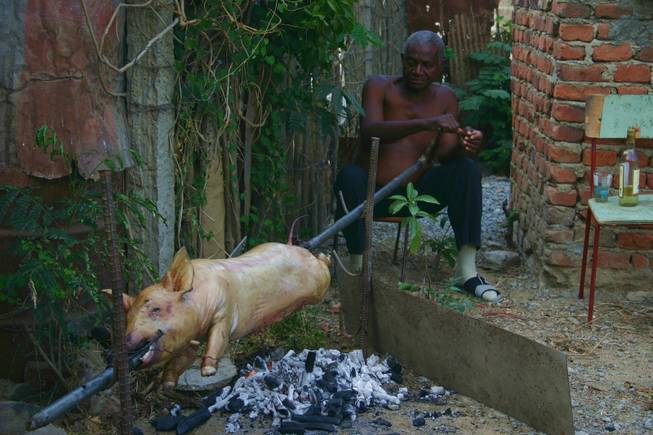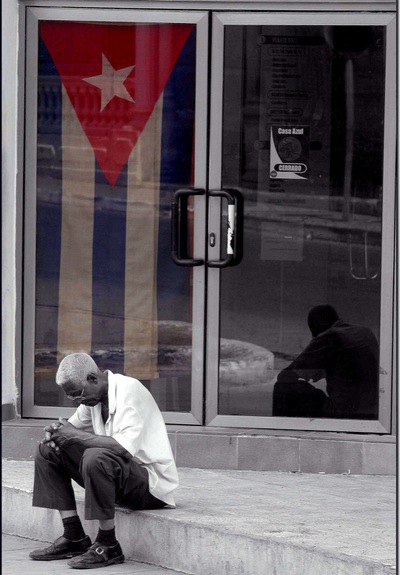
Courtesy photo
One of Maria and Eugenio Lopez’s photos from Cuba: “Pancho.” A Las Tunas resident cooking a pig in the traditional Cuban way. Roasting a pig in Cuba is another way of celebrating (whether it’s a homecoming of a family member or any other occasion) It’s a Cuban tradition, much like the turkey is in the United States.
Saturday, Nov. 1, 2008 | midnight
In April 2006, a couple from northwest Las Vegas traveled deep into the heart of Cuba — into a province called Las Tunas — and experienced life inside a country that has largely secluded itself from the rest of the world for more than 50 years.
Maria and Eugenio Lopez documented their two-week journey with a series of vivid photographs that will be exhibited inside the Sahara West Library. "Cuba Por Dentro," or "Inside Cuba," will be on display from Saturday to Dec. 1.
Sahara West Library is at 9600 W. Sahara Ave. near the corner of Sahara Avenue and Fort Apache Road.
Despite Cuba's economic struggles, Maria Lopez described Las Tunas as a beautiful landscape rich in culture.
"The family roots go back very far in that region," she said. "It was definitely the real heart of Cuba. There were no tourists there. We were the only tourists in the whole area."
Although Maria Lopez was born in Cuba, she had never been to Las Tunas. Her husband, Eugenio, was born and raised in that province.
Maria Lopez has been a crime scene analyst for Metro Police for the past 14 years while Eugenio, a 6-year resident of Las Vegas, is a professional artist who specializes in ceramics, pottery and photography.
"We had to ask permission from the United States government to go on the trip," Maria Lopez said. "You can only travel there once every three years."
Their plane flight landed in the province of Holguin, where they took a taxi westward to Las Tunas.
The cattle farms and marshy wetlands harvested for sugarcane were a far cry from the glitz and glamour of 1950s-era Havana that many people think of, Maria Lopez said.
"It's very rural. We wanted to show the common people and how they live, roasting pork or cleaning their clothes by hand," Maria Lopez said.
Eugenio Lopez described Las Tunas as a very artistic community of more than 500,000 residents.
"There are murals and paintings that adorn buildings all over the town," he said.
There was not much gasoline available, and of the few cars in the province, most were built in the 1950s. The vast majority of transportation was done via walking, horse-drawn carriage or "bicitaxi'' — a bicycle with two seats in the back.
One of the exhibit's photographs, entitled "Pancho," shows a local resident roasting a pig over an open fire, a celebratory tradition in Las Tunas — whether it be for the homecoming of a family member or any other reason.
"It's a Cuban tradition, much like how cooking a turkey is here in the United States," Maria Lopez said.
There were only two television channels available — one of them was Cuba's political channel and the other constantly showed episodes of the crime drama "CSI."
"Everyone was always glued to the channel with CSI," Maria Lopez said. "It was very strange."
Another photograph called "Hope" depicts a man sitting on a curb — with the Cuban flag draped behind him — waiting for a store to open.
The photograph symbolizes the Cuban people's hope of an "opening" of their country to the rest of the world through political change and freedom of expression, Maria Lopez said.
"We were trying to capture the essence of the people," she said. "It's a much simpler life. There was very little technology. It's the people that make the town."
Jeff O’Brien can be reached at 990-8957 or [email protected].


Join the Discussion:
Check this out for a full explanation of our conversion to the LiveFyre commenting system and instructions on how to sign up for an account.
Full comments policy